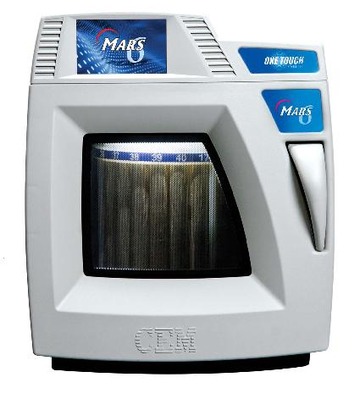
CEM outlines the advantages of using microwave technology in the laboratory.
While cooking with microwaves might be met with snobbery in some culinary circles, there are multiple applications and benefits for their use in the laboratory.
Today microwaves are being used in everything from fat and protein analysis to extraction and dry ashing.
Increased speed
One of the primary benefits across all uses of microwave technology is increased speed due to its ability to produce higher temperatures than the more traditional hotplate.
For example, when used in microwave digestion, temperatures that are significantly higher than what is achievable at atmospheric boiling point are attainable.
This also allows chemists to sidestep the problem of dissolving samples on a hotplate without high pressure vessels.
Use in organic and inorganic synthesis
These higher temperatures can also be used to advantage in organic and inorganic synthesis, where microwave technology can be used in place of more traditional heating methods to speed up the reaction process.
An example is CEM’s Phoenix Range of Ashing Systems which enables ash samples to be dried much more rapidly than when a traditional ‘muffle furnace’ is used.
It also allows the use of more convenient crucibles, such as porcelain or glass.
Improving preparatory work
Microwave technology has also been adapted to do much of the preparatory work for chemists.
For example MARS 6 from CEM automatically recognises the vessel type, counts the vessels and determines the necessary parameters for a fast, complete reaction.
The in-built technology means chemists can let the MARS 6 do most of the analysis for them.
Reducing the use of solvents
Another advantage of microwave technology is that is negates the need for the use of large amounts of solvents, which are both costly and damaging to the environment.
This is the case when microwaves are used for either microwave extraction or microwave fat analysis.
The use of Nuclear Magnetic Resonance technology (NMR) in microwave fat analysis means that fats and oils can now be detected through an entire sample, as opposed to merely on the surface.
Overall, the use of microwave technology in fat analysis can lead to precision of 0.01 per cent.
Environmental advantages
In addition to the clear practical efficiencies in the laboratory, using microwaves in a laboratory context also has clear environmental advantages.
Energy requirements are much lower when compared to the use of other heat sources, and because significantly fewer solvents are used, a smaller amount of harmful waste is generated.
Microwaves also require fewer consumables in order for processes to be conducted. This means microwave technology hits the holy trinity of being time efficient, financially efficient and environmentally efficient.







